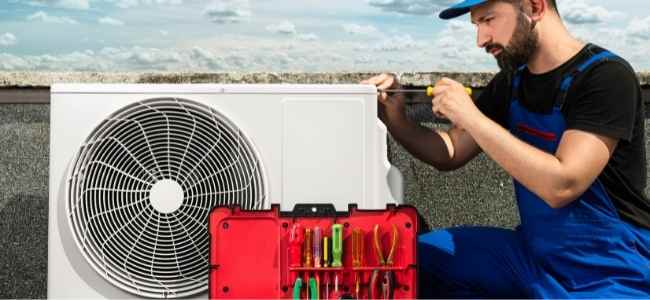Finding water in places where you shouldn’t in your home can make you a bit concerned. Not only are you concerned about the source of the leak and the cost of repairing it, but you will also be concerned about the damage the leak will cause to your home. Now, if it’s your AC leaking, you will need to do something quickly to prevent further damage and costly repair bills.
In case you realize that your AC is leaking, take the following steps immediately to prevent further damage:
- Turn off your air conditioner. This will prevent the water from leaking and protect your unit from additional damage.
- Clean the water that might have leaked out of the system to protect your walls, ceiling, floors, furniture, and décor.
With that said, here are the three major reasons why your AC might be leaking, and how to fix the problem.
Frozen AC evaporator coils
There are a few reasons why your AC might be leaking and one of these reasons is a clogged air filter. If your AC’s air filter is clogged, air will not pass through it efficiently. This, in turn, can lead to frozen evaporator coils. Now, because refrigerant flows through the evaporator coils, and requires efficient airflow to absorb heat, restricted airflow can lead to the formation of ice and dripping water.
In addition, dirty coils, faulty blower motor, lack of refrigerant, or blocked registers/vents can lead to frozen evaporator coils. If the evaporator coils are frozen, it means that the refrigerant cannot take in the hot air from your home. The result of this is increased temperatures in your home as well as possible problems with the compressor.
So, if you notice that the evaporator coil is frozen, turn your AC unit off immediately. Please avoid turning it on again until you deal with the cause of the problem. Also, replacing the air filter every one to three months, and avoiding covering the air registers or vents can help to prevent the evaporator coils from freezing.
It’s recommended that you replace your air filters more regularly during the summer season because this is the time when your AC system runs for longer periods of time. However, if changing the air filter and cleaning all the vents doesn’t fix your leaking AC, chances are you are running low on refrigerant, and this issue requires the attention of professional AC technicians.
Overflowing or cracked drain pan
An AC drain pan is found beneath the indoor air handler, and it catches the condensation from the AC unit. To inspect the drain of the pan, you will need to turn off the AC unit first then check both the drain pan and pipe for any possible leaks. The drain pipe is connected to the drain pan and it releases the condensate outside your home.
Clean the overflow pan with a wet-dry vacuum and then inspect the bottom, edges, and corners using a flashlight. If the drain pan is cracked, you can use a water sealant to fix the problem temporarily. However, you should ensure that you replace the damaged drain pan as soon as you can.
Please note that AC units have two drain pans: one pan is located beneath the evaporator coils, and it’s permanently fixed, while the removable pan is located beneath the AC unit. So, if you opt to repair the leak, you must leave the permanent drain pan in place as you do the repairs. In case the primary pan requires replacement, you will need a professional AC technician to do the job because it’s welded in place. However, you can replace the auxiliary pans without a challenge if you love DIY tasks.
Blocked condensate drain line
The experts from Hartman’s air conditioning repair company say that this is another reason why your AC might be leaking. Fixing this issue is a possible DIY project so long as you have the right tools—a wet-dry vacuum. Mostly, condensate drain lines are clogged because of debris, fungi, or algae accumulation. That’s why it’s essential to clean the drain line regularly. You can do this job or call an expert to do it.
The following are the steps of cleaning a clogged drain line:
- Find the PVC pipe close to the drain pan of the air handler. You should see a piece of the pipe facing upwards at a 90-degree angle, and it has a little cap.
- Remove the cap and pour one cup of vinegar into the drain line. This will help to kill any fungi or algae that might have developed in the drain line. Now, if the drain line is still blocked after doing this procedure, you will need to decide whether to use a wet-dry vacuum to clean the line or call an expert to do the job.
- Find the outdoor drain line, which is near the condenser unit, and connect it to the wet-dry attachment before turning on the vacuum. You can find the attachment that connects a wet-dry vacuum with an outdoor drain at any home improvement store. You should expect your AC to stop leaking once you finish vacuuming the drain line.
Modern AC units come equipped with automatic shut-off switches for blocked condensate lines and air filters. So, if your air conditioner fails to turn on, check the drain line and air filter first. If you notice that the drain line is not connected properly, you will need to schedule a professional repair.
One of the best ways to prevent your AC from freezing is scheduling a regular AC maintenance program—at least twice a year. Also, you should ensure that your annual tune-ups include all-around cleaning and drain line clearing.


